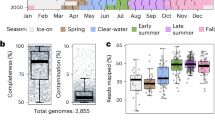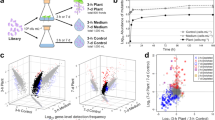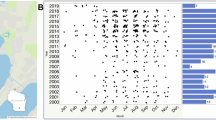Abstract
Bacterial genomes evolve in complex ecosystems and are best understood in this natural context, but replicating such conditions in the lab is challenging. We used transposon sequencing to define the fitness consequences of gene disruption in the bacterium Caulobacter crescentus grown in natural freshwater, compared with axenic growth in common laboratory media. Gene disruptions in amino-acid and nucleotide sugar biosynthesis pathways and in metabolic substrate transport machinery impaired fitness in both lake water and defined minimal medium relative to complex peptone broth. Fitness in lake water was enhanced by insertions in genes required for flagellum biosynthesis and reduced by insertions in genes involved in biosynthesis of the holdfast surface adhesin. We further uncovered numerous hypothetical and uncharacterized genes for which disruption impaired fitness in lake water, defined minimal medium, or both. At the genome scale, the fitness profile of mutants cultivated in lake water was more similar to that in complex peptone broth than in defined minimal medium. Microfiltration of lake water did not significantly affect the terminal cell density or the fitness profile of the transposon mutant pool, suggesting that Caulobacter does not strongly interact with other microbes in this ecosystem on the measured timescale. Fitness of select mutants with defects in cell surface biosynthesis and environmental sensing were significantly more variable across days in lake water than in defined medium, presumably owing to day-to-day heterogeneity in the lake environment. This study reveals genetic interactions between Caulobacter and a natural freshwater environment, and provides a new avenue to study gene function in complex ecosystems.
Similar content being viewed by others
Log in or create a free account to read this content
Gain free access to this article, as well as selected content from this journal and more on nature.com
or
References
Cao M, Goodrich-Blair H. Ready or not: microbial adaptive responses in dynamic symbiosis environments. J Bacteriol. 2017;199:e00883–16.
van Gestel J, Vlamakis H, Kolter R. Division of labor in biofilms: the ecology of cell differentiation. Microbiol Spectr. 2015;3:MB-0002-2014.
Vos M, Wolf AB, Jennings SJ, Kowalchuk GA. Micro-scale determinants of bacterial diversity in soil. FEMS Microbiol Rev. 2013;37:936–54.
Azam F, Malfatti F. Microbial structuring of marine ecosystems. Nat Rev Microbiol. 2007;5:782–91.
Stocker R. Marine microbes see a sea of gradients. Science. 2012;338:628–33.
van Opijnen T, Camilli A. Transposon insertion sequencing: a new tool for systems-level analysis of microorganisms. Nat Rev Microbiol. 2013;11:435–42.
Kwon YM, Ricke SC, Mandal RK. Transposon sequencing: methods and expanding applications. Appl Microbiol Biotechnol. 2016;100:31–43.
Price MN, Wetmore KM, Waters RJ, Callaghan M, Ray J, Liu H, et al. Mutant phenotypes for thousands of bacterial genes of unknown function. Nature. 2018;557:503–9.
Wetmore KM, Price MN, Waters RJ, Lamson JS, He J, Hoover CA, et al. Rapid quantification of mutant fitness in diverse bacteria by sequencing randomly bar-coded transposons. mBio. 2015;6:e00306–15.
Poindexter JS. Biological properties and classification of the Caulobacter group. Bacteriol Rev. 1964;28:231–95.
Poindexter JS. Dimorphic prosthecate bacteria: the genera Caulobacter, Asticcacaulis, Hyphomicrobium, Pedomicrobium, Hyphomonas and Thiodendron. In: Dworkin M, Falkow S, Rosenberg E, Schleifer K-H, Stackebrandt E, editors. The prokaryotes: volume 5: Proteobacteria: alpha and beta subclasses. New York, NY: Springer New York; 2006. p. 72–90.
Wilhelm R. Following the terrestrial tracks of Caulobacter - redefining the ecology of a reputed aquatic oligotroph. ISME J. 2018. https://doi.org/10.1038/s41396-018-0257-z.
Allen HL. Primary pproductivity, chemo‐organotrophy, and nutritional interactions of epiphytic algae and bacteria on macrophytes in the littoral of a lake. Ecol Monogr. 1971;41:97–127.
Ely B. Genetics of Caulobacter crescentus. Methods Enzymol. 1991;204:372–84.
Drever JI. The geochemistry of natural waters: surface and groundwater environments. Englewood Cliffs, NJ: Prentice Hall; 1997.
Brunberg AK, Nilsson E, Blomqvist P. Characteristics of oligotrophic hardwater lakes in a postglacial land-rise area in mid-Sweden. Freshw Biol. 2002;47:1451–62.
Carlson RE. Trophic state index for lakes. Limnol Oceanogr. 1977;22:361–9.
Christen B, Abeliuk E, Collier JM, Kalogeraki VS, Passarelli B, Coller JA, et al. The essential genome of a bacterium. Mol Syst Biol. 2011;7:528.
Pitcher DG, Saunders NA, Owen RJ. Rapid extraction of bacterial genomic DNA with guanidium thiocyanate. Lett Appl Microbiol. 1989;8:151–6.
Kent WJ. BLAT-the BLAST-like alignment tool. Genome Res. 2002;12:656–64.
Marks ME, Castro-Rojas CM, Teiling C, Du L, Kapatral V, Walunas TL, et al. The genetic basis of laboratory adaptation in Caulobacter crescentus. J Bacteriol. 2010;192:3678–88.
Schrader JM, Zhou B, Li GW, Lasker K, Childers WS, Williams B, et al. The coding and noncoding architecture of the Caulobacter crescentus genome. PLoS Genet. 2014;10:e1004463.
Ritchie ME, Phipson B, Wu D, Hu Y, Law CW, Shi W, et al. Limma powers differential expression analyses for RNA-sequencing and microarray studies. Nucleic Acids Res. 2015;43:e47.
Curtis PD, Brun YV. Identification of essential alphaproteobacterial genes reveals operational variability in conserved developmental and cell cycle systems. Mol Microbiol. 2014;93:713–35.
DeJesus MA, Ambadipudi C, Baker R, Sassetti C, Ioerger TR. TRANSIT-a software tool for Himar1 TnSeq analysis. PLoS Comput Biol. 2015;11:e1004401.
Lee PO, McLellan SL, Graham LE, Young EB. Invasive dreissenid mussels and benthic algae in Lake Michigan: characterizing effects on sediment bacterial communities. FEMS Microbiol Ecol. 2015;91:1–12.
McMillan L, Stout R. Occurrence of Sphaerotilus, Caulobacter, and Gallionella in Raw and treated water. J Am Water Works Assoc. 1977;69:171–3.
Chao MC, Abel S, Davis BM, Waldor MK. The design and analysis of transposon insertion sequencing experiments. Nat Rev Microbiol. 2016;14:119–28.
Stephens C, Christen B, Watanabe K, Fuchs T, Jenal U. Regulation of D-xylose metabolism in Caulobacter crescentus by a LacI-type repressor. J Bacteriol. 2007;189:8828–34.
Stephens C, Christen B, Fuchs T, Sundaram V, Watanabe K, Jenal U. Genetic analysis of a novel pathway for D-xylose metabolism in Caulobacter crescentus. J Bacteriol. 2007;189:2181–5.
Galperin MY, Makarova KS, Wolf YI, Koonin EV. Expanded microbial genome coverage and improved protein family annotation in the COG database. Nucleic Acids Res. 2015;43:D261–9.
Hottes AK, Meewan M, Yang D, Arana N, Romero P, McAdams HH, et al. Transcriptional profiling of Caulobacter crescentus during growth on complex and minimal media. J Bacteriol. 2004;186:1448–61.
Ardissone S, Viollier PH. Interplay between flagellation and cell cycle control in Caulobacter. Curr Opin Microbiol. 2015;28:83–92.
Benson AK, Wu J, Newton A. The role of FlbD in regulation of flagellar gene transcription in Caulobacter crescentus. Res Microbiol. 1994;145:420–30.
Xu H, Dingwall A, Shapiro L. Negative transcriptional regulation in the Caulobacter flagellar hierarchy. Proc Natl Acad Sci Usa. 1989;86:6656–60.
Faulds-Pain A, Birchall C, Aldridge C, Smith WD, Grimaldi G, Nakamura S, et al. Flagellin redundancy in Caulobacter crescentus and its implications for flagellar filament assembly. J Bacteriol. 2011;193:2695–707.
Ely B, Croft RH, Gerardot CJ. Genetic mapping of genes required for motility in Caulobacter crescentus. Genetics. 1984;108:523–32.
Johnson RC, Ely B. Analysis of nonmotile mutants of the dimorphic bacterium Caulobacter crescentus. J Bacteriol. 1979;137:627–34.
Toh E, Kurtz HD Jr, Brun YV. Characterization of the Caulobacter crescentus holdfast polysaccharide biosynthesis pathway reveals significant redundancy in the initiating glycosyltransferase and polymerase steps. J Bacteriol. 2008;190:7219–31.
Kumar P, Kaushik A, Lloyd EP, Li SG, Mattoo R, Ammerman NC, et al. Non-classical transpeptidases yield insight into new antibacterials. Nat Chem Biol. 2017;13:54–61.
Bielnicki J, Devedjiev Y, Derewenda U, Dauter Z, Joachimiak A, Derewenda ZS. B. subtilis ykuD protein at 2.0 A resolution: insights into the structure and function of a novel, ubiquitous family of bacterial enzymes. Proteins. 2006;62:144–51.
Mira A, Ochman H, Moran NA. Deletional bias and the evolution of bacterial genomes. Trends Genet. 2001;17:589–96.
Martinez-Garcia E, Nikel PI, Chavarria M, de Lorenzo V. The metabolic cost of flagellar motion in Pseudomonas putida KT2440. Environ Microbiol. 2014;16:291–303.
Smith DR, Chapman MR. Economical evolution: microbes reduce the synthetic cost of extracellular proteins. MBio. 2010. https://doi.org/10.1128/mBio.00131-10.
Langridge GC, Phan MD, Turner DJ, Perkins TT, Parts L, Haase J, et al. Simultaneous assay of every Salmonella Typhi gene using one million transposon mutants. Genome Res. 2009;19:2308–16.
Loeb GI, Neihof RA. Marine conditioning films. Applied Chemistry at Protein Interfaces. Adv Chem. 1975;145:319-35.
Schneider RP, Leis A. Conditioning films in aquatic environments. Encyclopedia of Environmental Microbiology. John Wiley & Sons, Inc. New York, NY; 2003.
Loeffler F. Weitere Untersuchungen uber die Beizung und Farbung der Geisseln bei den Bakterien. Cent Bakteriol Parasitenkd. 1890;7:625–39.
Metsalu T, Vilo J. ClustVis: a web tool for visualizing clustering of multivariate data using Principal Component Analysis and heatmap. Nucleic Acids Res. 2015;43:W566–70.
Acknowledgements
This work was supported by UChicago BIG grant to SC and MLC, and NIGMS grant R01GM087353 to SC. KLH was supported by an NIH Ruth Kirschstein Postdoctoral Fellowship (F32 GM122242) and a Chicago Biomedical Consortium Postdoctoral Core Grant (FP064244-01-PR). LMRR was supported by the NIH Molecular and Cellular Biology Training Grant (T32 GM007183). PDC is supported an NSF CAREER award (1552647); he began the Tn5 library construction in the laboratory of Dr. Yves V. Brun at Indiana University. We thank the members of the Crosson laboratory for helpful discussions, Tom Ioerger (Texas A&M) for assistance with TRANSIT, Adam Deutschbauer (University of California-Berkeley) for the E. coli APA752 strain, and David Hershey for construction of the C. crescentus CB15 Himar transposon library. We also thank Pieter Faber and Abhilasha Cheruku from the University of Chicago Genomics Facility for technical advice and helpful discussions, and Kasia Kluszczynska, Xiomy Alejandro-Navarreto, Lydia Varesio, and Olivia Stovicek for help with lake water collection.
Author information
Authors and Affiliations
Corresponding authors
Ethics declarations
Conflict of interest
The authors declare that they have no conflict of interest.
Electronic supplementary material
Rights and permissions
About this article
Cite this article
Hentchel, K.L., Reyes Ruiz, L.M., Curtis, P.D. et al. Genome-scale fitness profile of Caulobacter crescentus grown in natural freshwater. ISME J 13, 523–536 (2019). https://doi.org/10.1038/s41396-018-0295-6
Received:
Revised:
Accepted:
Published:
Issue date:
DOI: https://doi.org/10.1038/s41396-018-0295-6
This article is cited by
-
Mutualism reduces the severity of gene disruptions in predictable ways across microbial communities
The ISME Journal (2023)
-
Nutrient complexity triggers transitions between solitary and colonial growth in bacterial populations
The ISME Journal (2021)
-
Genome Comparisons of Wild Isolates of Caulobacter crescentus Reveal Rates of Inversion and Horizontal Gene Transfer
Current Microbiology (2019)



